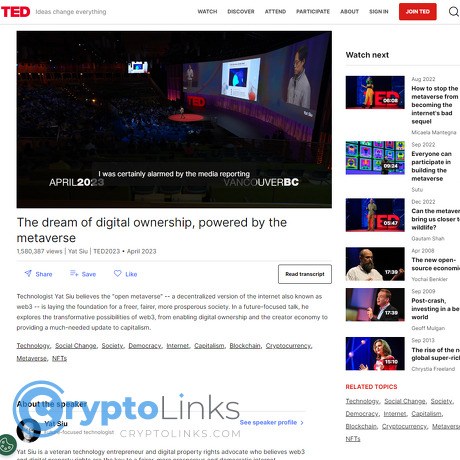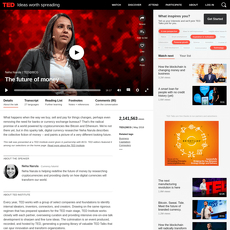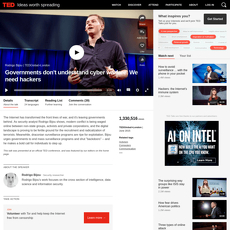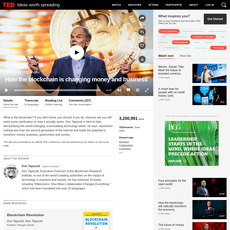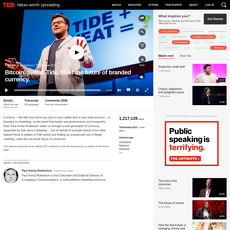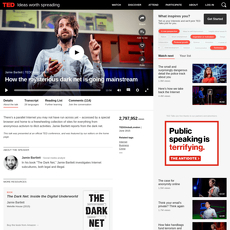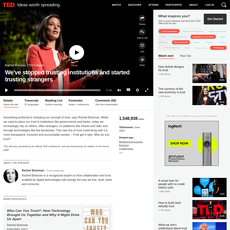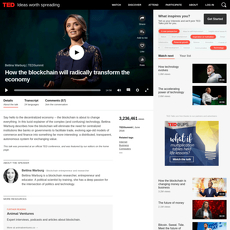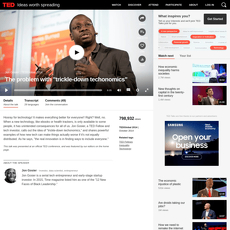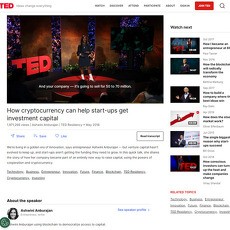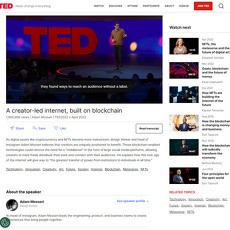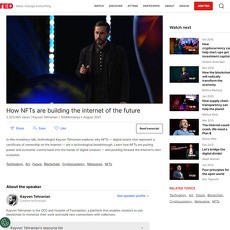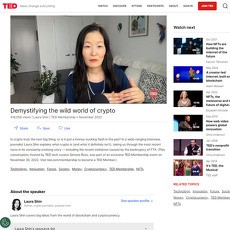Yat Siu: The dream of digital ownership, powered by the metaverse Review
Yat Siu: The dream of digital ownership, powered by the metaverse
www.ted.com
Yat Siu’s Metaverse Manifesto: Why Digital Ownership Matters (TED Talk Review + Guide & FAQ)
What if the next thing you create online was actually yours—you could move it between apps, monetize it on your terms, and keep it even if the platform shut down?
That’s the simple but powerful promise laid out in Yat Siu’s TED Talk. And it’s the kind of shift crypto was built to unlock. I’m going to unpack the talk in plain English and translate it into clear, practical moves you can make—whether you build, play, create, or invest.
Describe problems or pain
Right now, most of us rent our online lives from platforms.
We pour time and money into digital stuff—profiles, followers, game items, skins, playlists—but we don’t actually own it. It lives inside closed platforms that set the rules, take the fees, and can change everything overnight.
Real-world examples you’ve probably seen:
- Platforms can shutter and take your value with them. When Google shut down Stadia, players lost a lot of progress and in-game history; refunds helped, but not everything was portable (The Verge).
- Rule changes can crush whole ecosystems. Remember the 2023 Reddit API price shift that wiped out beloved third‑party apps overnight? Creators and communities had zero leverage (The Verge).
- Developers face unilateral fees and pivots. The Unity runtime fee fiasco showed how fragile creator economics are when a platform can change terms mid‑journey (The Verge).
- Game items vanish when servers do. Publishers regularly turn off online services for older titles, and your digital goods disappear with them (PC Gamer).
- You can’t take your stuff with you. The skins you bought in one game are worthless outside it. Years of reputation on one social app don’t follow you to the next.
On top of that, NFTs and the “metaverse” got a bad rep in 2021–2022 thanks to scams and speculation. The tech headlines moved faster than the utility. If you’re thinking, “Sounds cool, but what does this do for me today?” — you’re not alone. Chainalysis even flagged wash trading and market manipulation as major pain points in early NFT markets (Chainalysis).
Here’s the kicker: people already value digital goods. Players spend billions every year on in‑game content (see Newzoo’s ongoing market reports for scale: Newzoo). But those goods are locked inside walled gardens. The gap between what we value and what we control is the pain.
Promise solution
I’m going to:
- Explain Yat’s core thesis in plain English: digital property rights and why they change incentives for everyone.
- Show where it fits in crypto today—real use cases, not vaporware.
- Share practical moves for creators, gamers, founders, and investors (plus a quick checklist).
- Answer the questions I get all the time—yes, including “Isn’t the metaverse dead?”
By the end, you’ll have a clear summary of the talk and a set of next steps you can act on immediately.
What you’ll learn and who this is for
- What “digital property rights” actually mean: why owning an asset on-chain is different from holding a license in a database.
- Why interoperability matters: assets that move across apps and games unlock compounding utility and value.
- How culture turns tokens into living assets: communities, IP, and meaning drive demand—tech is the rails.
- How to use this in the real world: practical steps for tokenizing access, building with open standards, and investing with an interoperability lens.
This is for creators, gamers, founders, investors, and anyone crypto‑curious who wants the signal without the noise.
Curious why this message hits different in 2025—and why the messenger matters? Next up, I’ll show you who’s behind this thesis and why his track record should make you sit up. Ready to meet the guy putting real money and products behind these ideas?
Who is Yat Siu—and why should crypto folks care?
Yat Siu isn’t the kind of speaker who floats grand ideas without skin in the game. He’s the co-founder and chairman of Animoca Brands, the company behind The Sandbox and a sprawling portfolio of Web3 games, tools, and IP deals. Over the years, I’ve watched his work quietly wire the backbone for what many of us actually want from crypto: digital rights that mean something when platforms change their rules.
“Own the things you love online, and the internet changes who holds the power.”
Track record that matters
This isn’t just talk. Animoca has shipped products, licensed real IP, and backed builders who are still here after the speculation washed out. A few proof points worth caring about:
- The Sandbox: a user-generated world where land and items live on-chain. It’s hosted launches with Snoop Dogg, Adidas, and Warner Music Group—evidence that culture moves where ownership is respected.
- REVV Motorsport: when the F1 Delta Time license ended, Animoca didn’t strand users. They created a support plan so assets retained utility across the broader racing ecosystem—a real-world stress test for what “user rights” should look like when deals change.
- TinyTap and teacher income: experimenting with “Publisher NFTs” that share revenue with educators, pushing licensing into education instead of just art. See the results announcement here: Animoca + TinyTap NFT sale.
- Mocaverse: an identity and loyalty layer for users across Animoca’s network—one wallet, many apps, consistent reputation and benefits. It’s a practical route to interoperability people can feel, not just read about.
- Portfolio depth: hundreds of investments across gaming, NFTs, and infrastructure (portfolio), giving Yat a wide-angle view of what actually gets adoption vs what’s noise.
- Policy influence: appointed to Hong Kong’s Task Force on Promoting Web3 Development in 2023 (Gov announcement), he’s been pushing for frameworks that protect users while letting builders ship.
Why this matters: gamers already spend tens of billions of dollars on digital items each year, mostly locked inside walled gardens. Newzoo estimates the global games market at well over $180B in 2023 (Newzoo), and DappRadar’s quarterly reports routinely show that Web3 gaming drives a big chunk of on-chain activity (DappRadar industry reports). If even a fraction of that spend becomes portable and user-owned, the stakes aren’t small—they’re internet-sized.
What he brings to the TED stage
Yat connects culture, gaming, and ownership into a message that’s simple enough for your non-crypto friends to feel in their gut: if your wallet holds your stuff the way your pocket holds your house keys, then platforms serve you—not the other way around.
- Builder-first credibility: it’s not theory; it’s products with real users and recognizable IP, showing how on-chain rights unlock new business models.
- Everyday logic: if you pay for a digital item, you should be able to sell it, lend it, or use it elsewhere. That’s what tokens and open standards enable when you design for portability from day one.
- Resilience when things break: licenses end, companies pivot. The REVV example shows a path where user assets keep meaning, even when a title shuts down. That’s how ownership should behave online.
I’ve seen too many communities lose everything because a platform changed course overnight. Hearing someone on a TED stage say, in plain terms, that users deserve property rights hits different when you’ve lived through rug pulls, shuttered servers, or one-size-fits-all policy.
Why his view stands out in 2025
The market’s grown up. The froth is gone; the builders stayed. And what’s left aligns with Yat’s long-held stance:
- Rights over hype: the narrative isn’t quick flips—it’s wallets as identity, assets with utility, and creators who keep their upside.
- Interoperability as ROI: assets that work in multiple apps compound value. That’s as true for game items as it is for memberships and media licenses.
- Aligned incentives: open standards let startups bootstrap with communities instead of paying rent to platforms that can pull the plug.
And the data’s pointing the same way: games keep leading on-chain activity (DappRadar), while big brands continue testing tokenized loyalty and on-chain access because fans respond when ownership is real. The takeaway? This isn’t about chasing a trend. It’s about fixing the internet’s incentive problem with tools that already work.
So what exactly did he argue on the TED stage—and how does it translate into today’s internet you use every day? Keep reading; the next section breaks his core idea into a simple, no-jargon playbook.
The TED Talk in plain English: core thesis and structure
Key message
The internet we use today runs on rental agreements. Platforms own the data, the items, the social graphs, and the rules. If they tweak an algorithm or shut down a feature, your “assets” melt away. The big unlock here is simple: on-chain assets turn your online life into property, not permits. A wallet becomes your universal account, and tokens/NFTs are portable proof that something—an item, an identity, a membership—belongs to you.
That flips the power dynamic. Instead of permissioned access controlled by a single app, you get verifiable ownership that moves across apps. Think of it as a shift from platform-first to user-first rails:
- Data portability: Use the same wallet (and reputation) to log in with Sign-In with Ethereum across products.
- Asset portability: Your ERC-721 or ERC-1155 token works wherever it’s recognized—games, marketplaces, social apps.
- Incentive alignment: Open ownership lets third-party builders add value without asking for permission, which tends to compound network effects over time.
This isn’t theory. People already pour money into digital goods. Researchers and market trackers estimate that gamers alone spend tens of billions every year on skins and in-game items (see Newzoo for market overviews). The catch is those goods are usually stuck in walled gardens. Web3 says: keep the value, lose the walls.
How he tells the story
He starts where most of us feel it: games and culture. If you’ve ever bought a skin in Fortnite or traded a CS:GO knife, you already understand the emotional and financial pull of digital stuff. The talk connects that instinct to a rights-based framework using tokens and NFTs.
Here’s the plain-English version of how tokens encode real rights:
- Scarcity: On-chain supply is public and auditable. No secret over-minting behind the scenes.
- Provenance: You can see who created it and every transfer since. That’s how artists and brands keep credibility.
- Programmable utility: Smart contracts can grant access (token-gated communities), perks (in-game boosts), or economics (royalties, revenue splits).
- Composability: Other apps can detect and use your asset without closed-door partnerships—if you hold X, unlock Y. Open by default.
Real-world touchpoints worth knowing:
- Avatars across worlds: Ready Player Me avatars work in hundreds of apps and worlds, a taste of “buy once, use many.”
- Shared identity: ENS names and on-chain profiles carry reputation across apps; protocols like ERC-4337 and ERC-6551 make accounts and assets more flexible.
- Creator economics: NFT drops with utility (access, licensing) outperform pure collectibles over time, a pattern tracked by firms like Chainalysis and DappRadar during market cycles.
Put bluntly: what people already value online finally gets the property rights it deserves—and the freedom to move.
“The moment you can take your assets with you, the platform stops owning you.”
What makes it different from “metaverse hype”
Forget the goggles. This is not a VR pitch. It’s a standardization pitch. The center of gravity here is open protocols that any app can read, write, and build on—just like how the web exploded because HTTP and HTML were open.
- Open standards, not closed skins: ERC-20/721/1155 are shared languages for money and items.
- Composability beats walled partnerships: If you hold a token, any developer can build around it—no API key required.
- User custody by default: Assets live in your wallet, not an app’s database. Platforms compete on service, not on lock-in.
And there’s proof this model changes behavior. During the 2021–2023 cycle, projects that emphasized utility and interoperability saw steadier retention than one-off hype collectibles (again, check public analyses from Chainalysis and DappRadar). While speculation swung wildly, assets with use kept people around.
So, if the heart of the message is “own your digital life,” the next question is obvious: what are the building blocks that make ownership actually powerful—how do portability, interoperability, and culture turn a token into something alive? Let’s unpack that next.
Big ideas unpacked: ownership, interoperability, and culture
“Ownership isn’t a feature—it’s freedom. And freedom is portable.”
Digital property rights = power and portability
When an asset lives on-chain, it doesn’t care which app gave it to you. It’s yours. You can sell it on a marketplace, lend it into a protocol, rent it out, or point it at a brand-new app that didn’t exist yesterday. That’s not theory—I see it working every day.
- Trade where you want: A skin from a blockchain game or a membership NFT can be listed on any marketplace, not just the game’s internal shop. If a platform changes fees or rules, you still control the asset—and the exit.
- Rent and monetize without a middleman: Standards like ERC‑4907 enable “rentable” NFTs. Think metaverse land or game items you can lease for a weekend event. Protocols like rental marketplaces and peer-to-peer lending use the same token—you don’t have to beg a platform for permission.
- Financial utility: NFT-collateral lending (for example, Blend) lets holders unlock liquidity without selling. It’s imperfect and risky like any credit market, but it shows how property rights create optionality.
- Access everywhere: Token-gating tools such as Collab.Land let the same membership NFT unlock Discord, in-game lounges, newsletters, or IRL events. Your wallet is the keys; apps are just doors.
- Proof of presence and perks: POAPs (Proof of Attendance Protocol) turn moments into portable credentials. Holders can be rewarded across platforms with airdrops, tickets, or exclusive drops.
Reality check: creator royalties aren’t enforced by the chain itself (see EIP‑2981—a signaling standard, not a hard rule). But ownership still flips the power dynamic: users choose markets that honor creators, not the other way around.
Interoperability and composability
Interoperability is where things compound. Open standards let builders stack on each other’s work and users get more from a single asset. That turns one purchase into a passport.
- Standards are the rails: ERC‑721/1155 gave us a shared language for NFTs. Now, upgrades like ERC‑6551 (token‑bound accounts) let an NFT own other assets or act like a wallet. That means your avatar can hold items, XP, or subscriptions—portable across apps.
- Avatars across worlds: Ready Player Me avatars plug into thousands of apps and games. One identity, many environments. That’s interoperability users can feel, today.
- On‑chain games as open worlds: Projects like Dark Forest and frameworks like MUD keep state on-chain, so anyone can build side tools, bots, or entire spin‑off experiences without asking permission.
- Remix culture by default: Loot (text‑only bags) sparked dozens of games, art drops, and tools because the data and license invited it. Nouns runs on CC0—anyone can remix Noggles into toys, fashion, or content. Value accrues because the culture is forkable.
- Identity that moves: Social graphs like Lens and Farcaster let your followers and reputation travel with you. Post in one client, get read in another, monetize in a third.
The takeaway: open primitives make it cheap to experiment. One team’s NFT standard, another team’s game client, a third team’s marketplace—all slot together. Network effects show up faster because the “Lego bricks” are designed to fit.
Culture as the engine
Tokens don’t create demand on their own. Stories do. Communities do. Culture makes an asset feel alive—and keeps it relevant when markets wobble.
- Brands that treat holders like collaborators: Nike’s .SWOOSH experiments blur the line between fan and co‑creator, with digital wearables that connect to physical drops and future experiences. It’s not about a JPEG; it’s a membership into a living brand.
- Mass onboarding via familiar IP: Reddit’s collectible avatars brought millions into wallets through culture they already loved. Holders trade, customize, and unlock perks across subreddits—proof that mainstream communities will adopt wallets when the meaning is clear.
- Music, fandom, and utility: Platforms like Sound and Royal show how tracks, splits, and fan passes can live on-chain, spawning remix contests, private listening rooms, and transparent revenue sharing.
When culture leads, tokens become vessels for identity: your avatar, your club membership, your taste. That’s why interoperable assets matter—they carry the story into every new app, not just the one that minted them.
Why this matters now
The rules of the old internet are changing fast—fees jump overnight, APIs close, and games shut down with your items locked inside. Remember when social platforms throttled reach or priced their APIs out of indie hands? That’s platform risk. On-chain ownership limits that risk.
- If an app dies, your asset lives: The token and its metadata still exist on a public ledger. If art or game data is pinned to IPFS or Arweave, communities can rebuild viewers, spin up servers, or create new clients that read the same assets.
- Regulatory tightening favors transparency: Open standards and on-chain records are easier to audit than opaque server databases. That’s a tailwind for builders who design with user rights in mind.
- Users are voting with wallets: According to industry trackers like DappRadar, blockchain gaming consistently ranks among the top categories by daily active wallets—because utility compounds when assets move across apps.
In short: portability gives you leverage. You’re not begging a platform for permission—you’re choosing where your assets work hardest.
So what do you actually do with this? Which moves make sense if you’re a creator, gamer, founder, or investor—and which traps should you avoid? Keep reading; I’ll show you exactly how to turn these ideas into a practical checklist next.
What this means for you: creators, gamers, builders, investors
I love the big vision, but here’s where it turns into real moves you can make today. Ownership isn’t just a tech upgrade; it’s a shift in power—and it should change how you create, play, build, and allocate capital.
“Ownership is a feeling before it’s a feature. When people feel something is truly theirs, they show up differently.”
For creators and brands
Build assets people can use—not just admire. Treat wallets like your owned audience and design perks that travel with fans wherever they go.
- Tokenize access, not just art. Offer memberships, season passes, and licenses tied to utility. Example: Coachella’s “Keys” linked NFTs to real-world experiences (VIP access, exclusive events). That’s memorable—and measurable.
- Use wallets as your CRM (ethically). Analyze supporter cohorts by wallet (not cookies), then reward behavior. Tools to explore: Bello for collector insights, XMTP for wallet-to-wallet messages, Dune for on-chain dashboards.
- License like you mean it. Pick a clear, portable license that invites collaboration. Try a16z’s “Can’t Be Evil” licenses or go CC0 for open remix culture. Pudgy Penguins leaned into community IP and turned characters into toys and media, expanding beyond crypto silos.
- Think interoperable from day one. Want your avatars to show up in games and apps? Build with standards (ERC‑721/1155) and partner with networks like Ready Player Me, which plug avatars into thousands of apps.
- Store like it should last. Put metadata on IPFS or Arweave, not just a server link. If it breaks, your brand trust breaks.
- Measure what matters. Track holder retention, benefit redemption rates, secondary sales outside your own site (a signal of portability), and cross-app usage. If perks only work in one walled garden, you’re still doing Web2 with extra steps.
When fans feel seen and rewarded wherever they go online, they stick. That’s not theory—just look at how collectible ecosystems grow when utility compounds across platforms.
For gamers
If you’ve ever lost items when a game shut down or changed rules, this is your moment. Demand assets you can own, trade, and use beyond one title.
- Check for real ownership. Can you withdraw items to your wallet? Are the contracts public and verified on a block explorer? Games like Gods Unchained and Sorare let you trade your cards freely.
- Look for on-chain metadata. If stats and traits live only on centralized servers, they can be changed or removed. Prefer items with metadata pinned to IPFS/Arweave and clear token standards (ERC‑721/1155).
- Favor interoperable avatars and assets. Ready Player Me shows how one avatar can move across many apps. That’s the spirit you want in a game economy.
- Watch the economy design. Is there a transparent supply policy? Are there sinks and caps to prevent runaway inflation? If rewards only come from new users, it’s not a game—it’s a ticking clock.
- Red flags. “No withdrawals,” off-chain balance sheets, opaque ToS that allow item seizure, heavy reliance on first-party marketplaces, and admin keys that can freeze or replace contracts.
Players already spend billions on digital goods yearly; research from firms like Newzoo keeps confirming it. In parallel, secondary markets like CS:GO skins show how tradable items hold value through communities. Don’t settle for rent-only economies when ownership is possible.
For founders and devs
Your moat is the surface area other people can build on. Make your assets easy to integrate, your data easy to verify, and your incentives aligned with users.
- Ship with open standards. Base assets on ERC‑721/ERC‑1155, add creator royalty info with EIP‑2981, explore ERC‑6551 for token‑bound accounts, and improve UX with EIP‑4337 account abstraction and SIWE.
- Design for composability. Publish schemas and docs. Offer SDKs, subgraphs, and simple webhooks. Host a bounty for third‑party integrations. The more apps your items work in, the faster network effects kick in.
- Reward community contributions on‑chain. Use Ethereum Attestation Service for verifiable reputation, POAP for event proof, Gitcoin Passport to fight sybils. Replace “points in a spreadsheet” with portable attestations users can carry into other apps.
- Make assets useful beyond your app. Collaborate with games, worlds, and social platforms that let items travel. Think “avatars and items as APIs.” Ready‑to‑integrate art, animation rigs, and metadata save partners time and win you distribution.
- Be honest about control. If you use upgradeable proxies, add timelocks, multi‑sig governance, and public upgrade plans. Audit with OpenZeppelin and run a bug bounty. People won’t bring value into systems they can’t trust.
- Publish your economy policy. Detail mint limits, re‑issuance rules, sinks, and treasury plans. No “soft promises.” Put it in a versioned doc and on-chain where possible.
Interoperability isn’t a feature pile—it’s an invitation. When you design like your users will outgrow your app (because they should), they reward you by staying.
For investors
Great theses age well: user rights, portability, and composability. Look for teams that make assets more useful the longer they exist—and across more places.
- Signals you want:
- Withdrawals to self‑custody by default (not “coming soon”).
- Assets used in multiple third‑party apps/games (count the integrations).
- Clear IP/community loop: fan creations allowed and economically aligned.
- Open docs, verified contracts, active SDKs, public roadmaps.
- Metrics that actually matter:
- Wallet cohort retention (30/90/180 days), not just mints.
- Cross‑app usage: % of items transacting outside the issuer’s marketplace.
- Holder distribution and concentration (healthy Gini, fewer whales).
- Revenue split: primary vs secondary, plus take‑rate clarity.
- Dev velocity: shipped integrations, protocol contributions, audits.
- Where risk hides:
- Off‑chain metadata that can be changed silently.
- Upgradeable proxies with single‑signer admins and no timelock.
- “Interoperability” that’s really just API partnerships, not token standards.
- Royalty‑dependent business models with no alternative value accrual.
- Emissions‑driven growth without sinks or sustainable demand.
- Helpful research stack: Dune for custom dashboards, DappRadar for UAW trends, Token Terminal for revenue and protocol metrics. For infra bets, look at identity (e.g., ENS), attestations (EAS), avatar networks (Ready Player Me), and gaming rails (Immutable).
When in doubt, ask: if this app vanished tomorrow, would users still have something valuable in their wallets—and somewhere else to use it?
Want the exact talk link, quick viewing notes, and straight‑shooting FAQs (including “Is the metaverse dead?” and how to verify ownership fast)? I’ve put all of that right below—ready when you are.
How to watch, key links, and FAQs
Watch the talk here: Yat Siu — The dream of digital ownership, powered by the metaverse. If you like to skim or take notes, the full transcript is handy: TED transcript (English).
Quick viewing notes
- It’s tight (about 15 minutes) and idea-dense. I paused a few times to capture key phrases like “portability” and “interoperability” because they’re the engine behind the value he’s pitching.
- Watch how he ties ownership to culture. The strongest moments are when he shows why people value digital items in games and communities—and how on-chain rights turn that meaning into markets.
- Focus on “standards > skins.” It’s not a VR talk. He’s pointing to standards (think ERC-721/1155) that let assets move and compound utility across apps.
- Action tip: as you watch, list two assets you already use (game items, memberships, creator passes). Ask: If I truly owned these on-chain, where else could they work or earn?
When assets can leave the app, the app must earn your loyalty—this is the quiet revolution behind on-chain ownership.
FAQs people ask (straight answers)
What is the summary of a TED Talk?
A clean summary hits the core idea, the main arguments, a few memorable examples, and why it matters right now. For this one: Web3 makes digital property rights real and portable, which shifts value to users and creators and lets culture compound across apps.Is the metaverse dead?
No. The headset hype cooled, but the open metaverse—shared standards, portable assets, on-chain identity—is shipping in pieces you can use today. Examples you can check:- Gaming assets: On-chain items in titles like trading-card games can be bought/sold outside the game’s store and used in live matches—real utility, not just pictures.
- Token-gated access: Major ticketing platforms have already run NFT-gated presales and perks for fans, linking wallets to real-world access.
- Brand experiments: Big brands issue digital collectibles that unlock experiences and status across partner apps—early but growing. Industry reports keep showing steady on-chain activity even when prices are choppy.
Do NFTs actually do anything?
They can—when they’re tied to utility:- Access: Membership NFTs unlock communities, events, or token-gated content (think gated Discords, presales, backstage streams).
- In-game use: Cards, skins, or land pieces that work in live gameplay and can be traded on open markets.
- Licenses: NFTs can encode rights for creator IP, letting holders use assets within set terms (a growing trend with music/brand collaborations).
- Identity and reputation: Wallet-bound badges (e.g., conference attendance, grants, open-source contributions) form portable proof you can bring to other apps.
When NFTs are just images, interest fades. When they grant access, function in games, or carry rights, they behave like real property.
How do I verify true ownership?
Quick checklist you can run in under a minute:- Find the contract address from the project’s official site or verified marketplace page. Avoid copycats.
- Open a block explorer (Ethereum: Etherscan; Polygon: Polygonscan; Solana: Solana Explorer).
- Confirm the token (ERC-721/1155, collection name) and paste your wallet address to see your holdings.
- Check the token ID, ownership history, and metadata on the explorer’s “Token” or “Inventory” tab.
- Prove it to someone else? Sign a message with your wallet (no transactions!) to confirm you control the private keys. Never sign blind approvals.
What are the risks?
- Speculation and illiquidity: Prices move fast; some assets never develop real demand. Treat most NFTs like products or memberships, not guaranteed investments.
- Bad UX and custody traps: Custodial “NFTs” that you can’t withdraw aren’t real ownership. If you can’t move it to your wallet, it’s a rental.
- Closed ecosystems: Projects claiming “Web3” but blocking transfers, hiding contract code, or ignoring standards. Open standards are your friend.
- Royalty friction: Some marketplaces don’t enforce creator royalties. If you’re a creator, build utility and off-chain benefits so value doesn’t rely only on royalties.
- Security: Phishing is still the #1 threat. Use hardware wallets, verify contracts, and limit token approvals.
One more thing—before I give my blunt verdict on whether this talk is worth your 15 minutes, want the quick test I use to spot “Web3-in-name-only” projects in under 30 seconds? That’s next.
My verdict: Is Yat Siu’s TED Talk worth your time?
Yes. It’s a clear, no-jargon case for why on-chain ownership is the upgrade the internet needed all along. If you care about actual utility, not buzzwords, this is 15 minutes well spent.
What I liked
- Rights over hype. The talk centers on user rights and portability instead of VR tropes. That framing matches what’s working on-chain right now, from mass-market drops like Reddit’s Collectible Avatars on Polygon to token-gated access that travels between apps.
- Real hooks from gaming and culture. We’ve seen how digital goods create value even in Web2 (think skins and UGC). Web3’s edge is that assets aren’t stuck in one platform. Tools like tokenproof and Guild already let a single token unlock Discord communities, events, and websites—one purchase, many doors.
- Standards-first thinking. Interoperability isn’t a slogan; it’s a set of specs. ERC-721/1155 for ownership, ERC‑6551 for token-bound accounts (your NFT with its own wallet/inventory), and ERC‑4337 for smoother onboarding. Standards keep value portable even when apps change.
- Builder incentives backed by data. Despite market cycles, dev and infra momentum hasn’t gone away. Reports like Electric Capital’s Developer Report and the a16z State of Crypto 2024 show sustained open-source contributions and growing on-chain activity—exactly the soil interoperability needs.
What to watch for
- Ownership theater. If you can’t withdraw to a self-custody wallet, you don’t really own it. Check the contract address on a block explorer and verify transferability.
- Utility gap. Items with no use outside their birthplace won’t last. Look for open metadata, clear licensing, and integrations across apps—not just a marketplace listing.
- Interoperability washing. Claims are cheap. Real signals: public APIs/SDKs, on-chain metadata standards, assets loading in multiple environments (e.g., a game, a gallery, an event checker). Even social protocols like Farcaster show how portable identity and assets unlock new surfaces (Frames).
- Platform friction. App store policies and game marketplaces can block or tax crypto features. Apple’s rules still shape NFT UX, and Steam bans blockchain games. Expect more web + wallet flows until policies catch up.
- Royalties reality. Marketplace-level fees became optional in 2023–2024. Creators should plan business models that survive fee changes: memberships, licenses, and on-chain access, not just secondary sales.
What to do next
A 30‑minute portability audit you can run today:
- Self-custody check: Move one asset you care about to a wallet you control. Verify on a block explorer that it sits under your address.
- Metadata check: Open the tokenURI and see where files live. On-chain, IPFS, or Arweave = better longevity than a private server.
- License check: Does the project publish rights clearly? Compare against the open “Can’t‑Be‑Evil” templates (GitHub). Rights without clarity are risky.
- Interoperability test: Use the same asset to unlock two different surfaces (e.g., token-gate a Discord via Guild, then use it at an event with tokenproof). Portability should feel obvious.
- Standards sniff test: If you’re building, pick standards early: ERC‑721 or ERC‑1155 for assets, ERC‑4337 for smooth UX, ERC‑6551 for composable item inventories. Document an export path and publish your dev docs.
- Platform pressure: Ask products you use to support Sign‑In with Ethereum, let users export data, and honor open standards. Your assets shouldn’t be trapped.
- Investor checklist: Before backing a project, ask: Can users self-custody? Is metadata portable? Any real cross‑app integrations? Clear licensing? Public APIs? Healthy community retention beyond price talk?
Conclusion
Ownership isn’t a buzzword—it’s a design choice that compounds across the whole internet.
I see this talk as a north star: build for real ownership, real utility, and user-first systems. If that’s the web you want, hit play, run the audit above, and start nudging every product you touch toward open standards and portability.
You’ll find this review on cryptolinks.com if you want to share it with your team or community. If you implement even one of these steps this week, you’ll feel the difference the next time a platform changes the rules—because your assets will come with you.

